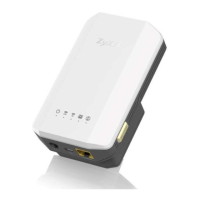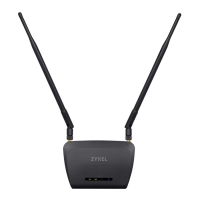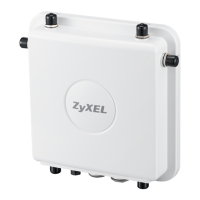WRE6606 User’s Guide
56
CHAPTER 10
Wireless LAN
10.1 Overview
This chapter discusses how to configure the wireless network settings in your WRE6606. See
Section 1.1 on page 9 for an overview of wireless networks.
10.2 What You Can Do
•Use the General screen to enable the Wireless LAN (2.4G/5G), enter the SSID and select the
wireless security mode (Section 10.4 on page 59).
•Use the AP select screen to choose an access point that you want the WRE6606 (in Client mode
and Repeater mode) to connect to. You should know the security settings of the target AP
(Section 10.6 on page 65).
•Use the MAC Filter screen to allow or deny wireless stations based on their MAC addresses from
connecting to the WRE6606 (Section 10.7 on page 69).
•Use the Advanced screen to allow intra-BSS networking and set the RTS/CTS Threshold (Section
10.8 on page 70).
•Use the QoS screen to enable Wi-Fi MultiMedia Quality of Service (WMMQoS). This allows the
WRE6606 to automatically set priority levels to services, such as e-mail, VoIP, chat, and so on
(Section 10.9 on page 71).
•Use the WPS screen to enable WPS to quickly set up a wireless network with strong security,
without having to configure security settings manually (Section 10.10 on page 72).
•Use the WPS Device screen to add a wireless station using WPS (Section 10.11 on page 73).
•Use the Scheduling screen to set the times your wireless LAN is turned on and off (Section
10.12 on page 74). This screen is available only when the WRE6606 is in AP mode.
•Use the Guest WLAN screen to configure multiple BSSs on the WRE6606 (Section 10.13 on
page 75). This screen is available only when the WRE6606 is in AP mode.
10.3 What You Should Know
Every wireless network must follow these basic guidelines.
• Every wireless client in the same wireless network must use the same SSID.
The SSID is the name of the wireless network. It stands for Service Set IDentity.
• If two wireless networks overlap, they should use different channels.
Like radio stations or television channels, each wireless network uses a specific channel, or
frequency, to send and receive information.

